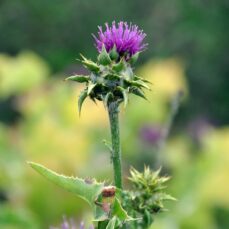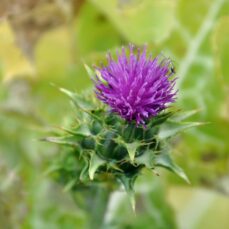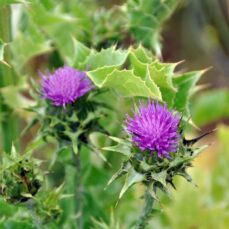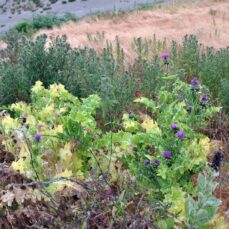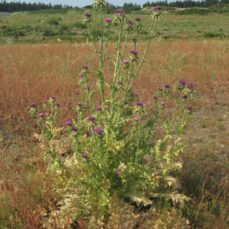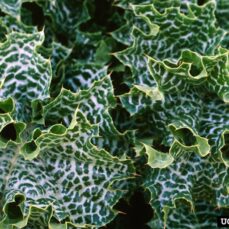
Photo credit: J. Leekie
Management Category
Squamish
Whistler
Pemberton
Vectors of Spread
Synonyms
Milk thistle is also known as:
- Blessed milk thistle
- Spotted thistle
- Variegated thistle
ID Characteristics
Flowers: Large purple flowers 2 – 6 cm in diameter and mildly scented. Flowers sit atop long spined bracts (a leafy seat from which a flower arises).
Stems: Mature plants have hollow 0.6 – 2.0 m tall stems. Both stem and leaf exude a milky sap when cut.
Leaves: Milk thistle has two types of leaves. Basal leaves form a thick, succulent rosette on the ground; clasping stem leaves are shiny and green with distinct white marbling patterns along the veins on deeply
lobed leaves.
Fruits: The seeds are black and brown and 8 mm long, slightly flattened with a ring of bristles (pappus) at one end.
Roots: Taproot depth depends on plant size.
Similar Species
Although there are many other thistle species, it is worth noting that milk thistle can always be distinguished by the distinctive white marbling on its leaves.
Native lookalikes

Wavy Leaf Thistle (photo credit: R. W. Smith)
Wavy leaf thistle (Cirsium undulatum) has distinctive wavy leaves, and the upper leaf surface lacks spines. White hairs on the leaves make it appear grey.
Non-Native Lookalikes

Bull Thistle
Bull thistle (Cirsium vulgare) has lobed hairy leaves and very sharp spines on the stem.

Scotch Thistle (photo credit: J. Leekie)
Scotch thistle (Onopordum acanthium) is very tall, reaching 2m. It has a woolly appearance and spiny wings on the stem.
Origin and Habitat
Origin: Milk thistle is native to the Mediterranean region, western Asia and Russia. Milk thistle was originally imported as an ornamental or medicinal plant.
Habitat: Milk thistle grows well in areas with full sun and moist soils. It prefers nutrient-rich soils with high nitrogen levels. It can be found in disturbed soils such as roadsides, ditches, and pastures.
How It Spreads
Milk thistle is an annual or biennial herb, meaning that milk thistle’s life cycle can span one or two years.
Milk thistle germinates in fall and winter. Each plant can produce up to 6,000 seeds which stay viable in the soil for at least 9 years. Seeds have a tuft of white hair (called a pappus), which helps them disperse in the wind. Animal and human activity, rainwater and streams also spread milk thistle seeds.
Impacts
Ecological:
- Toxic to wildlife and livestock.
- Creates dense stands that are difficult to cross, reducing habitat and creating barriers.
- Reduces biodiversity.
Economic:
- Reduces livestock foraging areas.
- Reduces crop value.
Health:
- Milk thistle has large woody thorns that can pierce footwear.
- Forms dense stands that are very uncomfortable for people to move through, even on horseback.
Stop the Spread
Milk thistle is not yet found in the Sea to Sky region, but is found in neighbouring areas and may arrive here soon. The goal is to prevent milk thistle’s introduction by focusing on education and awareness. If prevention fails, the goal will become immediate eradication following the proposed SSISC EDRR protocol.
Learn to identify milk thistle: use the images presented on this profile page to learn how to identify milk thistle.
DO:
- Regularly monitor properties for weed infestations.
- Ensure soil and gravel are uncontaminated before transport.
- Check wildflower mixes to ensure that they do not contain milk thistle.
- Ensure that plants are disposed of in a garbage bag if found in floral arrangements to prevent seeds from spreading.
DO NOT:
- Do not unload, park or store equipment or vehicles in infested areas; remove plant material from any equipment, vehicles, or clothing used in such areas and wash equipment and vehicles at designated cleaning sites before leaving infested areas.
- Do not plant milk thistle in a garden, no matter how well-contained its enclosure may seem.
- Do not move soil that has been contaminated with milk thistle.
- Do not compost.
Control
Mechanical control:
- Dig or excavate in the early development stage, when the rosette first appears.
- If the plant is already flowering, cut and bag buds before excavation.
- Minimize soil disturbance (which encourages seed germination) by replacing any divots created while digging.
- Regular mowing/tilling can reduce weed progression but will not eradicate the plant.
- When tilling, clean machinery regularly to prevent root fragments from spreading to new sites.
- Wear protective clothing to avoid puncture wounds from the spines.
Chemical control:
Effective herbicides include triclopyr, 2,4-D, aminopyralid, and glyphosate.
We recommend that any herbicide application is carried out by a person holding a valid BC Pesticide Applicator Certificate. Before selecting and applying herbicides, you must review and follow herbicide labels and application rates; municipal, regional, provincial and federal laws and regulations; species-specific treatment recommendations, and site-specific goals and objectives.
Biological control:
There is no biocontrol available for this plant.
Milk Thistle Distribution in BC
Milk Thistle Factsheet
Having trouble viewing the factsheet? Don’t worry, all the information is included on this page. You can also contact us with any questions.
References
- City of Victoria, Milk Thistle Invasive Species Alert, https://www.victoria.ca/assets/Departments/Parks~Rec~Culture/Parks/Documents/invasive-species-milk-thistle.pdf
- Coastal Invasive Species Committee, Milk Thistle
- District of Saanich, Blessed Milk Thistle Invasive Species Alert
- Fraser Valley Invasive Species Society, Milk Thistle
- Invasive Plant Atlas of the United States, Blessed Milkthistle
- Invasive Species Compendium, Silybum marianum
- King County Noxious Weed Program, Milk Thistle Identification and Control
- Mayo Clinic, Milk thistle
- Missouri Botanical Garden, Silybum marianum
- The Spruce, How to identify and remove Milk Thistle






